Related Research Articles
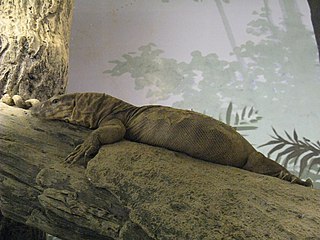
The yellow monitor or golden monitor is a species of monitor lizard found in South Asia. It is also called sun gohoro. It is also known as SANGOIH (सनगोहि) in Maithili and Svarna Godhika (স্বর্ণগোধিকা) in Bengali.

The Angolan slender mongoose is a mongoose native to southwestern Africa, specifically southwestern Angola and northwestern Namibia. It has been listed as "Least Concern" on the IUCN Red List, as it is not threatened and thought to be common. It has a long, slim body and there are different colour forms, a black or dark brown form in the southern part of its range, and a yellowish- or reddish-brown form in the north. This mongoose inhabits dry, rocky habitats and feeds on insects, scorpions and small vertebrates.
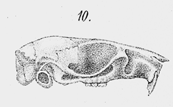
Oligoryzomys flavescens, also known as the flavescent colilargo or yellow pygmy rice rat is a species of rodent in the genus Oligoryzomys of family Cricetidae. It is found in southern South America, occurring in southern Brazil, Paraguay, Uruguay, and northeastern Argentina. Its karyotype has 2n = 64-66 and FNa = 66-70.
Mycobacterium flavescens is a species of the phylum Actinobacteria, belonging to the genus Mycobacterium.

The yellow mud turtle, also commonly known as the yellow-necked mud turtle, is a species of mud turtle in the family Kinosternidae. The species is endemic to the Central United States and Mexico.
The yellow serotine is a species of vesper bat.
The greater red musk shrew is a species of mammal in the family Soricidae. It is found in Lesotho, Mozambique, South Africa, and Eswatini. Its natural habitats are moist savanna, temperate grassland, and rural gardens. Like most shrew species, C. flavenscens is nocturnal. The greater red musk shrew is considered to be asocial and territorial, with males using scent marking to establish their territory. Males appear to be more aggressive than females, and their aggression increases with greater population density.

The Jamaican fig-eating bat is a species of bat in the family Phyllostomidae. It is the only living species in the genus Ariteus. The scientific name translates as "yellowish and warlike". There are no recognised subspecies.
Banksia rufa subsp. flavescens is a subspecies of Banksia rufa. It was known as Dryandra ferruginea subsp. flavescens until 2007, when Austin Mast and Kevin Thiele sunk all Dryandra into Banksia. Since the name Banksia ferruginea had already been used, Mast and Thiele had to choose a new specific epithet for D. ferruginea and hence for this subspecies of it. As with other members of Banksia ser. Dryandra, it is endemic to the South West Botanical Province of Western Australia.
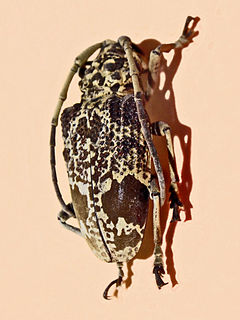
Phryneta is a genus of flat-faced longhorn beetles belonging to the family Cerambycidae.
P. flavescens may refer to:

Phrynetini is a tribe of longhorn beetles of the subfamily Lamiinae. It was described by Thomson in 1864.

The Castilloa Borer is a species of beetle in the family Cerambycidae. It was described by Johan Christian Fabricius in 1775, originally under the genus Lamia. It has a wide distribution throughout Africa. It feeds on Morus alba, Hevea brasiliensis, Coffea arabica, and Chlorophora excelsa.
Phryneta luctuosa is a species of beetle in the family Cerambycidae, also called lamiines or flat-faced longhorned beetles. It was described by Murray in 1870. It is known from Cameroon and Nigeria.

Phryneta macularis is a species of beetle in the family Cerambycidae. It was described by Harold in 1879. It is known from the Democratic Republic of the Congo and Angola.
Phryneta atricornis is a species of beetle in the family Cerambycidae. It was described by Léon Fairmaire in 1893. It is known from Comoros.
Phryneta coeca is a species of beetle in the family Cerambycidae. It was described by Chevrolat in 1857. It is known from Tanzania, the Central African Republic, the Ivory Coast, Cameroon, the Democratic Republic of the Congo, and Togo.
Phryneta ellioti is a species of beetle in the family Cerambycidae. It was described by Charles Joseph Gahan in 1909. It is known from Uganda and the Democratic Republic of the Congo.
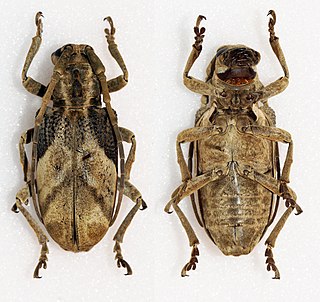
Phryneta semirasa is a species of beetle in the family Cerambycidae. It was described by Dohrn in 1885. It is known from Tanzania, the Democratic Republic of the Congo, Mozambique, Zimbabwe, Malawi, and Zambia.
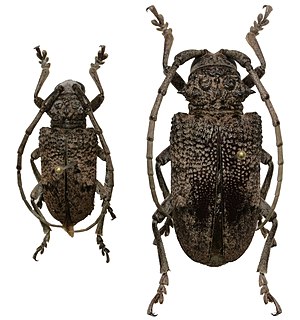
The Fig-tree Borer Longhorn Beetle, or Fig Tree Borer, is a species of beetle in the family Cerambycidae. It was described by Johan Christian Fabricius in 1792, originally under the genus Lamia. It has a wide distribution throughout Africa. It feeds on Pyrus communis, Ficus carica, Salix babylonica, Cupressus sempervirens, and Vitis vinifera.
References
- ↑ BioLib.cz - Phryneta flavescens. Retrieved on 8 September 2014.